Imagine the smell of freshly-baked bread, the taste of tender, flavorful meats, and the crunch of crisp vegetables, all combined to create the perfect sandwich. With an incredible array of possibilities, sandwiches have long been a staple food item in the culinary world, appealing to a broad range of tastes and preferences. This journey into the world of sandwiches will delve into the history of this beloved dish, explore the various breads and ingredients used to craft them, learn different techniques to bring out the best flavors, and even venture into regional creations that have become iconic in their respective locales. But that’s not all – we shall also delve into the realm of health, nutrition, and food safety to ensure that satisfying your sandwich cravings doesn’t compromise your well-being.
History of Sandwiches
The history of sandwiches dates back to ancient times, but the modern version that we know today can be traced back to the 18th century in England. The concept of placing different ingredients between two slices of bread is believed to have started during the reign of Rabbi Hillel the Elder in the first century B.C. He is known to have placed lamb and bitter herbs between unleavened bread during Passover, creating a simple form of a sandwich.
The name sandwich, however, has its origin in the life of John Montagu, the 4th Earl of Sandwich. An avid gambler, Montagu did not like to leave the gaming tables for extended periods, so he ordered a convenient meal which he could eat with one hand while continuing to play. His meal consisted of slices of cold meat between two slices of bread, which then became popular as the “sandwich” we know today. As this meal gained popularity, it spread across Europe, and people began to experiment with different ingredients and combinations.
With the colonization of various parts of the world, the concept of sandwiches spread across the globe, and local varieties emerged reflecting the influences of different cultures. In the United States, the sandwich has gone through several transformations, such as the arrival of the hamburger in the late 19th century, which has since become synonymous with American fast food culture. The culture of sandwiches was also embraced in various other countries, such as France’s famous baguette sandwiches, Italy’s panini, and Mexico’s tortas.
In many cultures, bread has always played a significant role as a staple food. This pre-existing importance of bread resulted in the easy adoption of sandwiches as a convenient and practical meal for various occasions. For instance, sandwiches offered an easy option for workers during the industrial revolution who needed quick, portable meals they could eat while on the go. The sandwich has also played a role in social gatherings, such as the English afternoon tea tradition where people would enjoy dainty sandwiches made of cucumber and salmon, among other ingredients.
The sandwich has experienced continuous evolution in its ingredients, preparation methods, and presentation styles. This diverse food item, which today comes in countless variations, can cater to a range of dietary needs, including vegetarian, vegan, and gluten-free options. The humble sandwich’s journey from a simple meal created by an English aristocrat to its widespread popularity around the world serves as a testament to its adaptability and the influence of culturally diverse innovations.

Types of Bread
White bread, made from wheat flour, is one popular type of bread used in sandwiches. This versatile bread is typically soft and has a light, mild flavor, making it well-suited for many sandwich variations. Examples of white bread include the French baguette, a long, narrow loaf with a crispy crust ideal for sandwiches like the submarine or Banh Mi, and the Italian ciabatta, characterized by its porous texture and chewy crust, perfect for paninis or other toasted sandwiches. The evolution of the sandwich, mapped by the diversity of its bread choices, illustrates how this food item continues to adapt and thrive in a range of culinary cultures.
Whole wheat bread is another commonly used type of bread in sandwiches. It is made using whole grain wheat flour, which includes the bran and germ, making it more nutritious than white bread. Whole wheat bread is often denser and has a nuttier, slightly bitter taste compared to its white counterpart. This type of bread pairs well with heartier sandwich fillings such as roasted meats, grilled vegetables, and strong cheeses. Whole wheat bread can also be found in various forms, such as the whole wheat pita, a round, pocketed bread ideal for stuffing with ingredients like falafel and vegetables.
Rye bread is a unique type of bread used for sandwiches, especially in traditional delis. Made with a combination of rye and wheat flours, this bread has a distinct tangy and slightly sour taste due to the fermentation process. Rye bread comes in different varieties, such as light or dark rye, depending on the ratio of rye and wheat flours used. The caraway seeds commonly found in rye bread add a distinctive flavor that pairs well with flavorful sandwich ingredients, such as corned beef, pastrami, and sauerkraut, making it the bread of choice for a classic Reuben sandwich.
Sourdough bread is another bread type known for its tangy and slightly sour taste, which is a result of the natural fermentation process that takes place during its preparation. Sourdough bread has a chewy texture and a thick, crispy crust that makes it an excellent choice for sandwiches that need a sturdy foundation, such as toasted and grilled sandwiches. It is particularly popular for paninis and grilled cheese sandwiches. Additionally, it complements a wide range of sandwich fillings, from savory meats and cheeses to creamy spreads and fresh vegetables.
Focaccia, an Italian flatbread, serves as an excellent sandwich bread, especially when sliced horizontally. This bread boasts a moist and slightly chewy texture, infused with flavors such as olive oil, rosemary, and sea salt. Focaccia sandwiches, or “focaccia al taglio,” can be filled with an assortment of Mediterranean-inspired ingredients like pesto, sun-dried tomatoes, grilled vegetables, and prosciutto, showcasing the delicious and easily customizable nature of sandwiches.
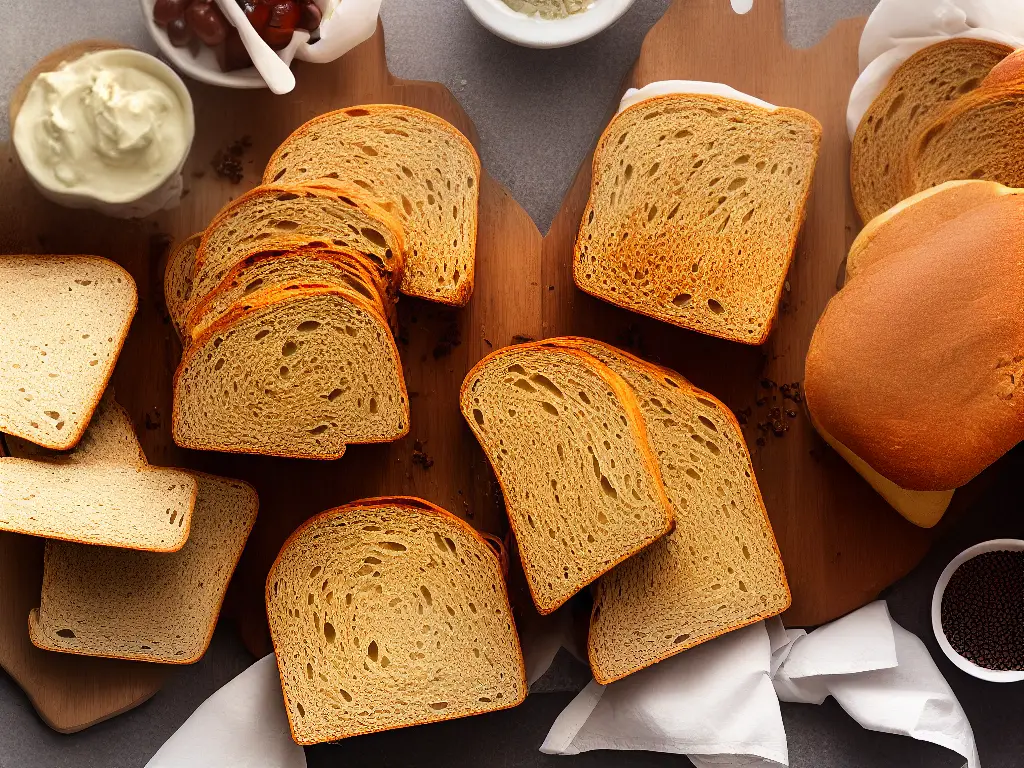
Sandwich Ingredients
Indeed, sandwiches offer a versatile and delightful meal option, with endless combinations of flavors and ingredients. Meat often forms the core of many sandwiches, ranging from thinly sliced deli staples like ham, turkey, and roast beef to more flavorful choices like salami, prosciutto or corned beef. Grilled meats such as chicken, steak, or burgers can also serve as a sandwich’s protein foundation. Alternatively, for vegetarians or those seeking lighter options, plant-based proteins like hummus, tofu, or tempeh can be used, further demonstrating the adaptability of sandwiches to suit various tastes and dietary preferences.
Cheese adds richness, flavor, and texture to sandwiches and is available in an amazing range of choices. Classic sandwich cheeses include American, Swiss, cheddar, provolone, and Monterey Jack. More adventurous palates might opt for unique varieties like smoked gouda, brie, or blue cheese. Vegan cheese options are also increasingly available, making it possible for those with dietary restrictions to enjoy a cheesy sandwich without compromise.
Adding vegetables to a sandwich not only enhances the flavor profile but also introduces a variety of textures and added nutritional value. Traditional sandwich veggies include lettuce, tomato, onion, and cucumber. However, the opportunities for creativeness are endless: avocado, sprouts, pickles, roasted red peppers, and coleslaw are popular additions, while grilled or roasted vegetables like zucchini, eggplant, or mushrooms can create a comforting and flavorful sandwich component.
Spreads and condiments can truly elevate a sandwich by adding moisture, flavor, and even a bit of spice. Classic sandwich spreads include mayonnaise and mustard, but options such as aioli, pesto, and hummus can give a unique twist. For spice lovers, hot sauces, sriracha, or even a flavorful salsa can add an exciting kick. Fruit preserves and chutneys can provide a sweet contrast to savory ingredients, while a thick layer of peanut or almond butter can turn a basic sandwich into a nostalgic treat.
When it comes to the art of sandwich-making, the selection of bread plays a crucial role in impacting the overall taste and satisfaction of the final product. Classic choices include hearty multigrain, soft white, or crusty baguettes, while alternative options may encompass pita pockets, tortilla wraps, or even lettuce leaves for a gluten-free or low-carb choice. The combination of ingredients used in a sandwich ultimately comes down to personal preference, but exploring the range of meats, cheeses, vegetables, spreads, and breads available is certain to result in some mouthwatering discoveries.
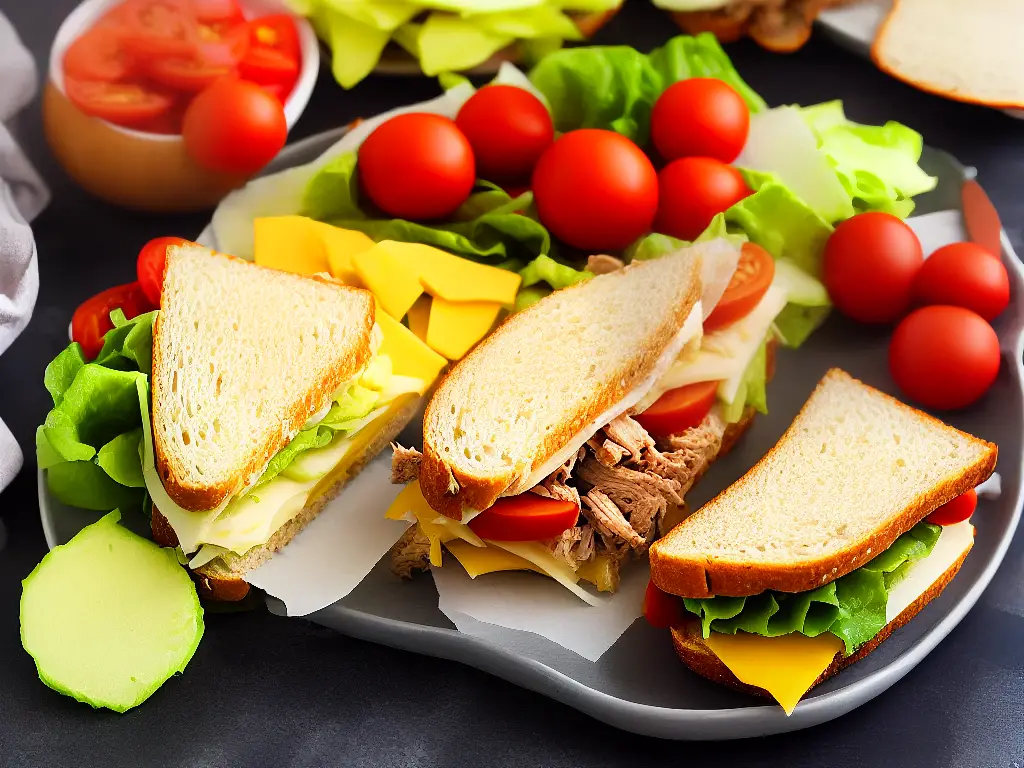
Sandwich-making Techniques
Moving beyond the type of bread, there is a whole world of techniques and approaches when crafting a sandwich that can significantly influence the overall culinary experience. Understanding the nuances of sandwich construction, from properly layering ingredients to considering the balance of flavors is essential for achieving an enjoyable dining experience. By paying attention to these important details, one can greatly enhance not only the flavor and texture but also the satisfaction derived from indulging in a delectable sandwich.
Choosing the Right Bread
The first critical decision when making a sandwich is the choice of bread. There are countless options, from soft white bread to dense, crusty artisan loaves. Consider the individual tastes and preferences of those who will be eating the sandwich, as well as any texture or flavor considerations necessary for the chosen ingredients. Lighter ingredients, such as fresh vegetables and lean meats, might work best with a softer, fluffy bread, while stronger flavors and heartier fillings are well-suited to a crusty, robust loaf. If a panini or grilled sandwich is desired, select bread that can withstand the heat and pressure of a panini press or griddle without becoming overly compressed or disintegrating.
Proper Layering
Proper layering is essential to creating a sandwich with good structural integrity and optimal flavor. For most sandwiches, it is best to start with a thin layer of a spread like butter, mayonnaise or a flavored aioli on one or both slices of bread. This can act as a sealant, preventing moist ingredients from seeping into the bread and causing sogginess. Additionally, the spread can provide an extra depth of flavor to the sandwich if expertly paired with the other ingredients. Next, consider the order of ingredients. Generally, it is a good idea to place meats and cheeses next to the bread, since they can create a barrier against moisture. After that, stack any vegetables or greens, taking care to arrange them in an even, appealing way.
Choosing Ingredients
When selecting ingredients to include in a sandwich, keep in mind contrasting textures and balanced flavors. A well-constructed sandwich should offer a mix of soft and crunchy, sweet and savory, and mild and bold. Look for opportunities to introduce a variety of textures, such as adding thin apple slices to a turkey sandwich with Brie, or including pickles or crispy onions to a roast beef and cheddar combination. This variety of texture will create an enjoyable eating experience.
Other Techniques and Strategies
The art of creating the ultimate sandwich involves numerous techniques and strategies that can significantly improve flavor and texture. One popular method is toasting the bread, which adds a satisfying crunch and enhances the taste of the other ingredients. Additionally, experimenting with global flavors and innovative ingredient combinations can elevate the humble sandwich into a culinary masterpiece. The key is to approach sandwich making with creativity, attention to detail, and an understanding of the techniques that will maximize flavor and texture.
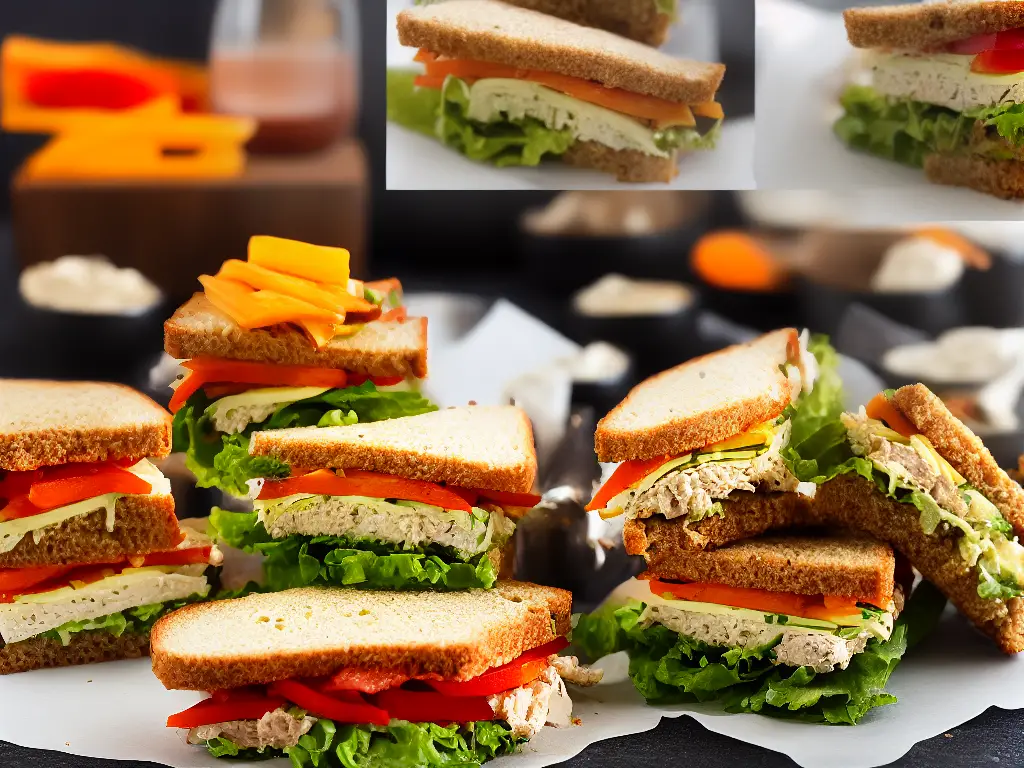
Sandwich Recipes
Taking these techniques and strategies into account, sandwiches become a versatile and delicious meal option that can be easily customized to suit individual tastes and preferences. There are countless sandwich recipes available, ranging from classic combinations to innovative and unique culinary creations. By collecting and studying various sandwich recipes, you can expand your culinary horizons and learn how to create your own mouth-watering masterpieces, perfect for lunch, dinner, or a quick snack.
Classic sandwich recipes often include tried and true combinations, such as the BLT, which features crispy bacon, fresh lettuce, and juicy tomatoes on toasted bread, accompanied by creamy mayonnaise. Another well-known option is the classic club sandwich, typically made with layers of thinly sliced turkey or chicken, bacon, lettuce, and tomato on toasted bread. These traditional recipes can serve as excellent starting points for creating your own adaptations and variations.
Innovative and unique sandwich creations often stem from combining elements of different cultures and cuisines, such as the Vietnamese banh mi sandwich. This flavorful fusion of French and Vietnamese ingredients features a crisp baguette filled with pickled vegetables, a choice of protein (typically pork, chicken, or tofu), and an assortment of herbs and seasonings, such as cilantro and jalapeno peppers. Similarly, the Mexican torta – a hefty sandwich made on a crusty bolillo roll – can be filled with numerous ingredients, like refried beans, avocado, various meats, and more.
Vegetarian and vegan sandwich recipes are also abundant, offering satisfying and protein-rich options that don’t feature meat. Hummus and vegetable sandwiches, for example, often combine the creamy, savory flavors of hummus with crunchy vegetables such as cucumbers, bell peppers, and onions. Other popular vegetarian options include avocado toast, grilled portobello mushrooms with pesto, or a classic grilled cheese with a twist, like adding fig jam or sliced apples for extra flavor and texture.
Embarking on a journey to study and experiment with various sandwich recipes can help you satisfy your cravings for classic staples as well as discover new and exciting flavor combinations to enjoy. By incorporating different types of bread, spreads, proteins, and vegetables, you can create an impressive assortment of sandwich options. Exploring the versatile world of sandwiches will not only broaden your culinary horizons but also allow you to develop sensational recipes that are sure to leave a lasting impression on your taste buds.
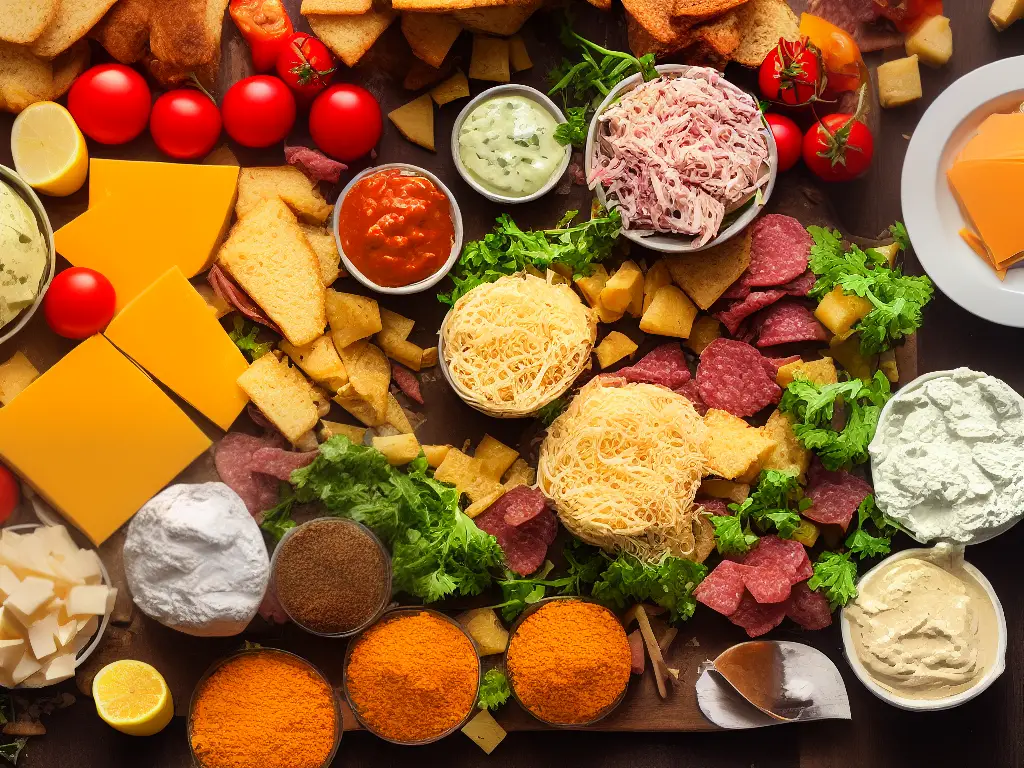
Regional Sandwiches
In the world of sandwiches, one of the most iconic and universally admired selections is the Italian panini. Characterized by its grilled, warm, crusty bread and tantalizing fillings made from fresh deli meats, cheese, and vegetables, it is no wonder that this toasted sandwich is a staple in cafes and shops around the world. To appreciate the panini’s authentic taste, explore Italian varieties such as the classic pairing of prosciutto and mozzarella, or venture into more elaborate creations like the Muffuletta, a popular panino filled with layers of olive salad, assorted deli meats, cheese, and pickled vegetables. Trying these genuine Italian recipes will take your sandwich expertise to the next level and provide you with a delicious, well-rounded understanding of this versatile culinary category.
Another culturally famous sandwich is the Vietnamese Banh Mi, which combines French influences with traditional Vietnamese ingredients. The sandwich is served on a French Baguette and typically filled with pickled vegetables, cilantro, spicy peppers, and a choice of meat such as sliced pork, pâté, or Vietnamese sausage. The harmony between the crispy bread and the fresh, vibrant flavors of the fillings make Banh Mi a sought-after sandwich across the globe. In Vietnam, Banh Mi is commonly enjoyed as street food, and the variations in fillings can vary based on the region or specific vendor.
In the United States, regional sandwiches vary significantly from coast to coast, showcasing local ingredients and culinary traditions. One such example is the Philadelphia Cheesesteak, a mouthwatering combination of thinly-sliced beef, melted cheese, and sautéed onions, all inside a long, soft roll. A symbol of Philly’s blue-collar culture, the cheesesteak can be found in numerous eateries across the city, with passionate devotees arguing about which establishment makes the ultimate version. Other notable American regional sandwiches include the New Orleans Po’boy, Maine’s Lobster Roll, and the Cuban Sandwich from Miami, each offering unique and delicious flavors that reflect their respective regional identities.
A traditional sandwich from the UK is the Cornish Pasty, a savory treat packed with various ingredients encased in a flaky pastry pocket. Though initially stuffed with beef, potato, onion, and swede, Cornish Pasties have expanded to include various flavors and fillings, such as chicken, vegetarian, or seafood options. Hailing from the county of Cornwall, these beloved pasties were once the perfect portable meal for working miners who needed a filling and easy-to-carry lunch.
Shawarma, a popular sandwich-like street food, originates from the Middle East and is enjoyed in various countries. Typically prepared by marinating meat such as chicken or lamb in a mixture of spices, shawarma is then slowly roasted on a vertical spit. The succulent, seasoned meat is thinly sliced and wrapped in a pita or flatbread, accompanied by vegetables, pickles, and various sauces. This flavorful creation has its roots in the Ottoman Empire and has since spread to various corners of the world, with regional adaptations reflecting local culinary traditions and ingredient availability.
![]()
Health and Nutrition
The popularity of sandwiches, like the shawarma, can be attributed to their convenience, versatility, and deliciousness. When considering the health and nutritional elements of these meal choices, it is crucial to examine the ingredients used in their construction. The various adaptations of the traditional sandwich reflect the diverse culinary landscapes and dietary preferences of different regions, making them appealing to a wide range of taste buds and nutritional needs.
The foundation of every sandwich is the bread, which can provide carbohydrates, fiber, minerals and vitamins. Opting for whole-grain breads, such as whole wheat or multigrain over white bread, ensures that you receive more nutrients and fiber, and a lower glycemic index, which aids in digestion and maintaining blood sugar levels.
The next component of a sandwich is the filling, which can vary greatly in terms of nutritional content. Lean proteins, such as grilled chicken, turkey, tofu or legumes, are great options for a healthy sandwich filler. They provide essential amino acids and help maintain muscle mass, keeping you feeling fuller for longer periods. Including a variety of vegetables in your sandwich adds vitamins, minerals and fibers to your meal, as well as enhancing flavor and texture. Fresh lettuce, spinach, cucumbers, tomatoes, and bell peppers are all excellent choices to incorporate into your sandwich.
Finding a balance between protein, carbohydrates, and fats is crucial in creating a healthy sandwich. Healthy fats, such as avocado or hummus, can be used as a spread instead of less healthy options like mayonnaise or butter. This substitution provides monounsaturated and polyunsaturated fats, which have been shown to positively impact heart health and may aid in reducing inflammation. Remember to keep portion sizes in mind, as too much of even the healthiest ingredients can lead to excessive calorie intake.
When it comes to condiments, choosing low-fat, low-sugar, and low-sodium options is essential for a nutritious sandwich. Examples of healthier condiments include mustard, salsa, or a light vinaigrette. Avoiding excessive amounts of high-fat dressings, or sugary sauces, can drastically lower the caloric intake and improve the overall nutritional value of your meal.
In order to enjoy a satisfying and healthy sandwich, it is crucial to consider your specific dietary needs and goals. Whether you are trying to lose weight or alter your macronutrient intake, modifying ingredients and portion sizes can help. For example, opt for an open-faced sandwich by using only one slice of bread to cut calories or incorporate lettuce wraps to increase your protein-to-carbohydrate ratio. With mindful decisions regarding ingredients and portions, sandwiches can undoubtedly be an integral part of your balanced diet, supplying essential nutrients and energy for everyday activities.
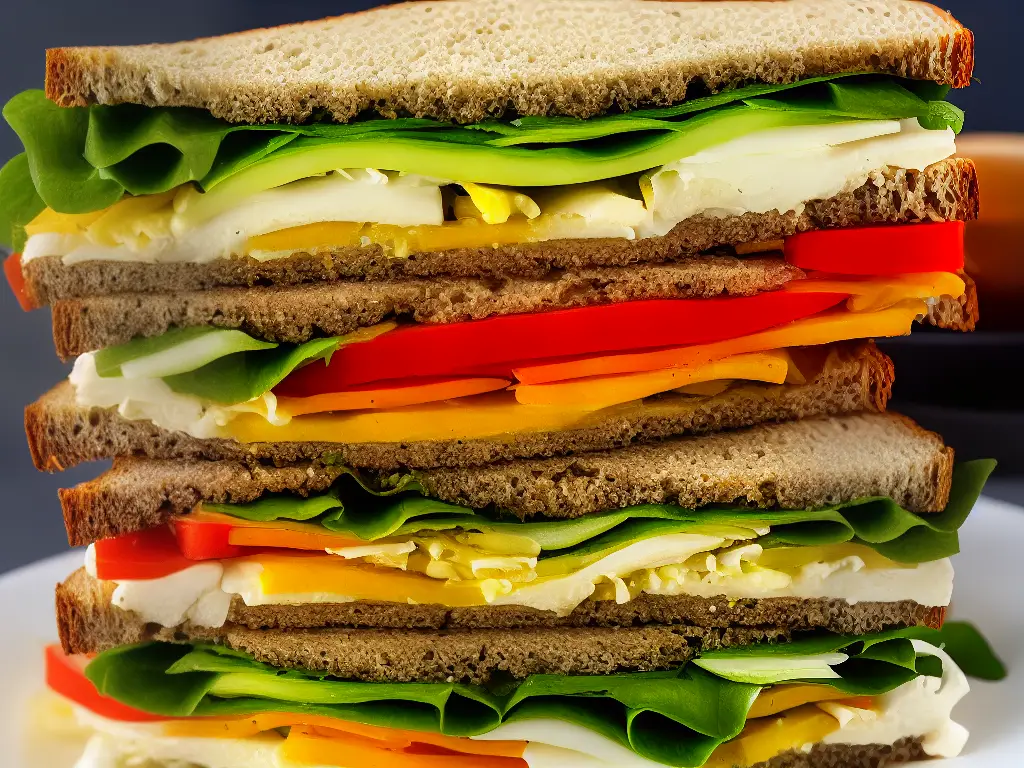
Food Safety and Storage
Another key aspect of enjoying delicious and healthy sandwiches is practicing proper food safety and storage. Ensuring that your sandwich ingredients are fresh and of high-quality plays a significant role in preventing foodborne illnesses and maintaining overall quality. When shopping for bread, deli meats, and produce, pay attention to expiration dates and avoid any items that appear damaged or spoiled. Don’t forget to check that perishable items like deli meats and cheeses are stored at the correct temperature (usually below 40°F) in the store’s refrigerated section before purchasing. Following these guidelines will ensure your sandwiches are both enjoyable and safe to consume.
When it comes to handling sandwich ingredients, it is crucial to maintain proper hygiene by washing hands thoroughly before and after handling food as well as regularly cleaning the surfaces and utensils used in food preparation. Raw ingredients, like fruits and vegetables, should be washed thoroughly with clean, running water to remove any potential contaminants. Moreover, avoid cross-contamination by using separate cutting boards and utensils for different types of foods, such as keeping raw meats separate from fresh veggies or bread.
Proper storage of sandwich ingredients is crucial to maintain their freshness and quality. Most perishable ingredients, including deli meats, cheeses, and condiments, should be stored in the refrigerator at or below 40°F. Breads and other baked goods can be stored at room temperature in a cool, dry place, although some people prefer to store certain bread types in the refrigerator to extend their shelf life. Fresh vegetables and fruits should be stored in the refrigerator’s crisper drawer, with each type of produce stored separately if possible to avoid accelerated ripening or spoilage.
Another key aspect of food safety for sandwich ingredients is knowing when it’s time to discard them. Regularly check the expiration dates of your ingredients, and promptly discard any items that have expired or show signs of spoilage, such as mold or a strange smell. Furthermore, pay attention to the shelf life of open containers, like condiments or spreads, and be mindful of their use-by dates.
When preparing sandwiches, it is essential to be mindful of the time perishable ingredients spend at room temperature to ensure their freshness, deliciousness, and safety. Bacterial growth can occur rapidly between 40°F and 140°F, so it is crucial to minimize the time that ingredients are exposed to this temperature range. To do this, only take out the ingredients you need during preparation and promptly return unused portions to the refrigerator. Additionally, when packing sandwiches for an event or outdoor gathering, consider using an insulated cooler with ice packs to keep perishable items cool and safe until they are ready to be eaten.
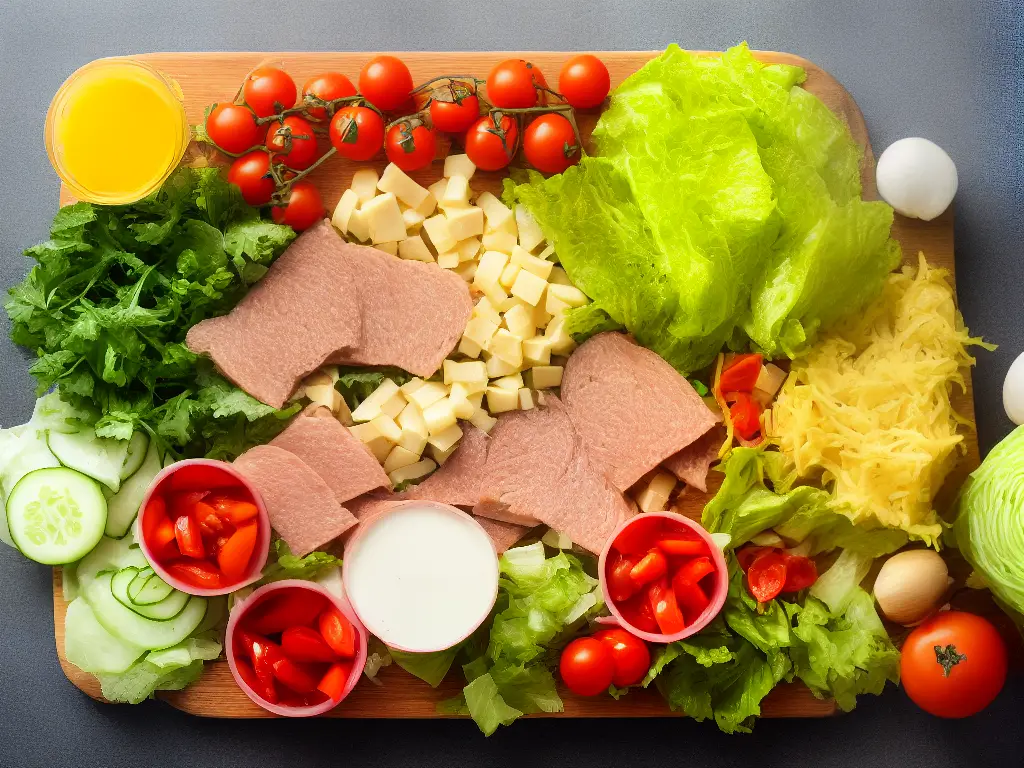
Sandwich Presentation
Moving on to the presentation aspect, an essential part of making a sandwich visually appealing lies in the color and arrangement of the ingredients. Including multiple colors like vibrant greens, deep reds, and bright oranges from vegetables such as lettuce, tomatoes, or bell peppers adds variety and excitement to the appearance of the sandwich. Layering the ingredients in an organized manner, with the meats and cheese neatly folded and the vegetables uniformly placed, can add order and structure to the dish. This careful arrangement not only enhances the appearance but also improves the overall taste and texture balance, reflecting the food safety and storage precautions taken earlier in the process.
The choice of bread is another crucial factor in sandwich presentation. Different types of bread present unique visual flair and texture to each mouthwatering creation. Options like sourdough or marble rye offer a rustic and artisanal appearance, while a croissant or bagel-based sandwich adds an international and gourmet touch. Toasting or grilling the bread is an excellent way to add a warm, golden hue, elevating the sandwich to the next level of visual appeal. Additionally, consider slicing the bread in various ways, such as diagonally, into neat triangles, or even stacking halves atop one another to create a small sandwich tower.
Garnishing the plate is another excellent opportunity to improve sandwich presentation. A well-placed leaf of lettuce, a sprig of parsley, or a vibrant pick of vegetables can add a touch of elegance to the dish. Side dish choices like coleslaw, potato salad, or a mixed greens salad can also provide a visually appealing complement to the sandwich. If serving warm sandwiches, consider adding a small ramekin of dipping sauce, such as au jus or marinara, to enhance both the flavor and appearance of the meal.
Creative serving ideas can further enhance sandwich presentation. Open-faced sandwiches, where the ingredients are artfully layered and displayed on a single slice of bread, showcase the internal components to the diner. Another idea is to deconstruct the sandwich, arranging the vegetables, meat, cheese, and bread separately in a bento box-style presentation. Miniature sandwich sliders or sandwich wraps can also provide variety and a creative twist to classic combinations.
Integrating unique and unconventional fillings can make a sandwich stand out visually and elevate the overall dining experience. Consider using alternative dressings like pesto, hummus, or avocado spread, which not only create a visual punch but also add layers of flavor. Furthermore, incorporating unexpected ingredients such as grilled fruits, roasted nuts, or candied bacon can bring textural variety and tantalizing elements that make the sandwich visually enticing and memorable for the person enjoying it.
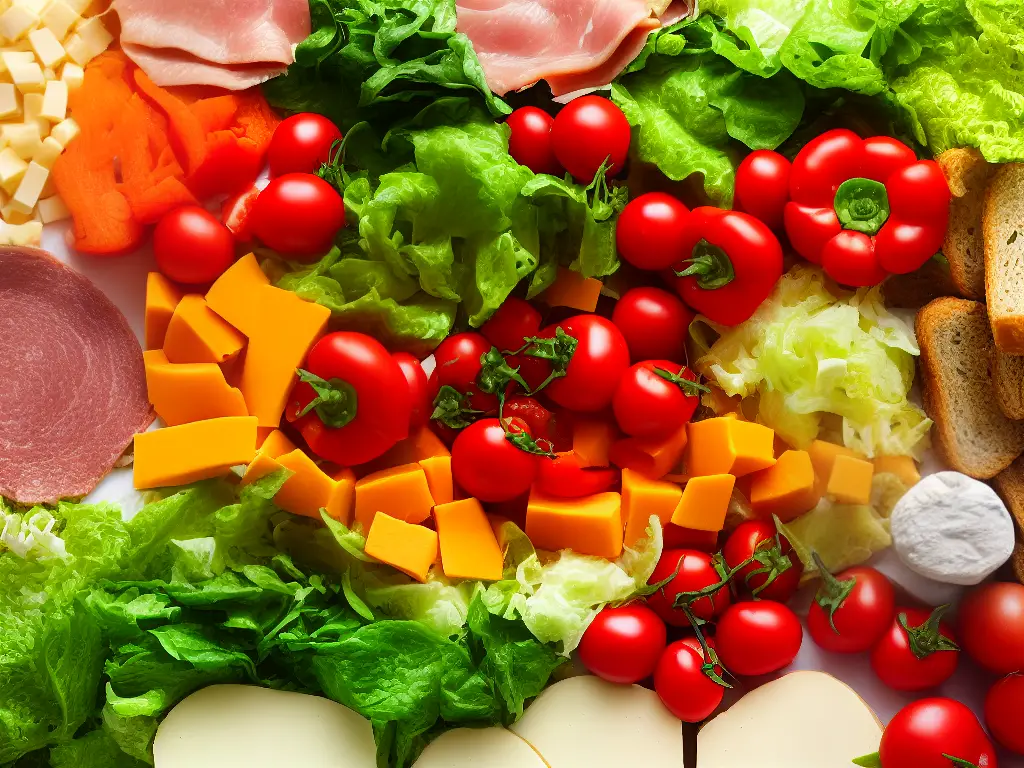
Catering and Sandwich Shops
This focus on diversity and customization in sandwiches is essential for the success of sandwich shops, franchises, and catering businesses, as it helps them appeal to a wide variety of customers. Sandwiches are popular for their adaptability to different dietary needs and preferences, offering both vegetarian and non-vegetarian options and a choice of breads and fillings. Ensuring that sandwiches can be tailored to accommodate specific tastes and dietary restrictions enables these businesses to cater to a broader audience and maintain high levels of customer satisfaction.
The operation of sandwich shops and franchises often depends on providing customers with a quick and convenient dining experience. Consequently, efficient service is vital to the success of these establishments. Many sandwich shops have mastered the art of preparing orders promptly and accurately, in addition to offering online ordering and delivery services to save customers’ time. These businesses also need to maintain strict food safety and hygiene standards to ensure the quality and freshness of their products.
Catering businesses, on the other hand, focus more on providing sandwich options for clients hosting events such as parties, corporate meetings, or weddings. When it comes to catering, providing customizable options and meeting clients’ specific needs are of utmost importance. For instance, if a client orders catering for a vegetarian event, the business must provide a variety of flavor-packed vegetarian sandwiches. Moreover, catering businesses need to possess the ability to handle larger-scale orders and logistics in order to successfully deliver and serve sandwiches at the event.
In recent years, sandwich franchises have gained significant popularity, providing entrepreneurs with the opportunity to own and operate a business under an established brand name. Opening a franchise involves entering a legal agreement with the franchisor that involves sharing profits, brand recognition, training, and support in exchange for adhering to specific guidelines set by the franchise. The franchisor will typically provide the franchisee with a proven business model and marketing support, ensuring consistency in the quality of the product and service across different locations. Franchisees benefit from this arrangement by receiving a pre-made blueprint for success, which can lower the risk of failure in comparison to starting an independent sandwich shop.
Another important aspect of sandwich shops and catering businesses is staying up-to-date with the latest food trends and innovations. With the increasing demand for healthier and sustainable food options, many sandwich businesses have begun offering alternatives, such as gluten-free bread, vegan cheese, and eco-friendly packaging. Furthermore, incorporating innovative flavors and international cuisine into their menus can help these establishments stand out from the competition and attract a diverse customer base. By staying in tune with the preferences and expectations of their clientele, sandwich businesses can continuously adapt and thrive in the ever-changing food industry.

Having traversed the diverse and delightful landscape of sandwiches, we are left with a newfound appreciation for their history, versatility, and cultural significance. The ingredients, breads, techniques, and presentation options open up a world of creativity and inspiration for sandwich enthusiasts. Furthermore, understanding the nutritional principles and proper storage methods ensures that enjoying these delightful creations can be both pleasurable and beneficial to our health. So, whether it’s a humble peanut butter and jelly or an elaborate gourmet creation, remember that each sandwich you make can be a delicious work of art that can bring joy and satisfaction to the taste buds of anyone who experiences it.